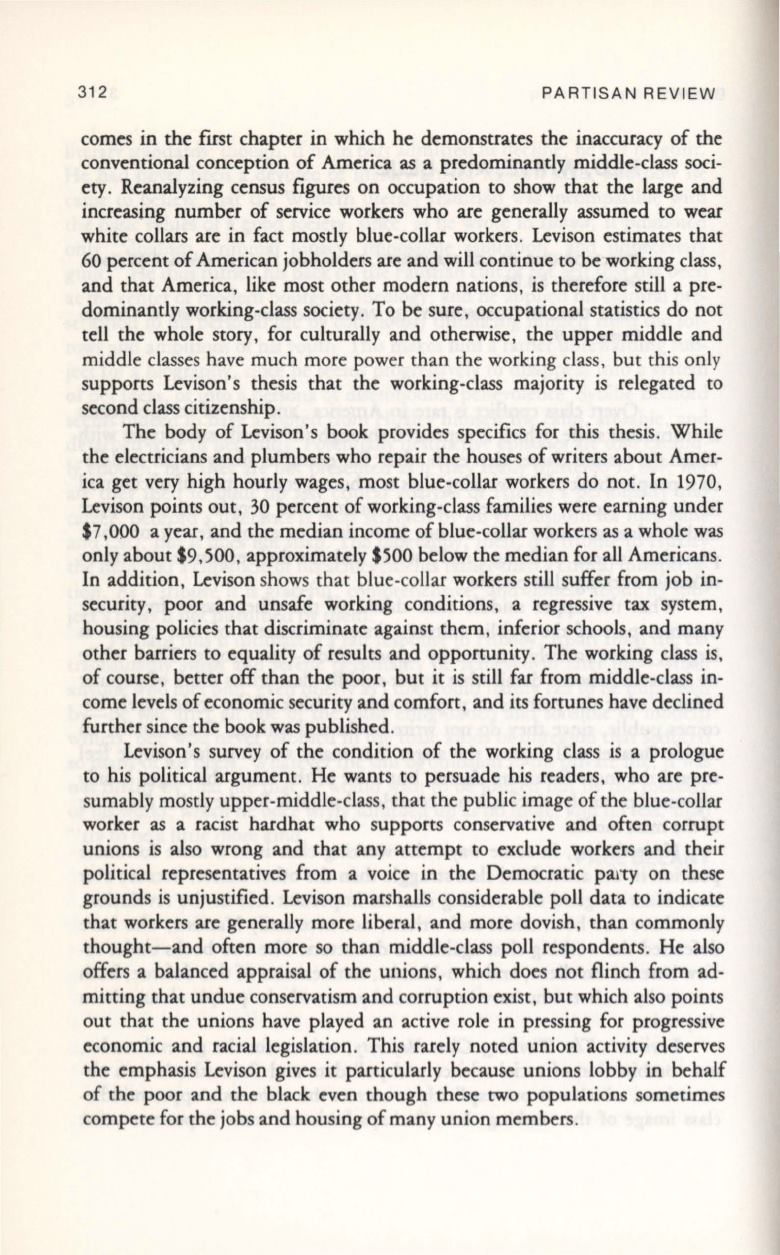
312
PARTISAN REVIEW
comes in the first chapter in which he demonstrates the inaccuracy of the
conventional conception of America as a predominantly middle-class soci–
ety. Reanalyzing census figures on occupation to show that the large and
increasing number of service workers who are generally assumed to wear
white collars are in fact mostly blue-collar workers. Levison estimates that
60 percent of American jobholders are and will continue to be working class,
and that America, like most other modern nations, is therefore still a pre–
dominantly working-class society. To be sure, occupational statistics do not
tell the whole story, for culturally and otherwise, the upper middle and
middle classes have much more power than the working class , but this only
supportS Levison's thesis that the working-class majority is relegated
to
second class citizenship.
The body of Levison's book provides specifics for this thesis. While
the electricians and plumbers who repair the houses of writers about Amer–
ica get very high hourly wages, most blue-collar workers do not. In 1970,
Levison points out, 30 percent of working-class families were earning under
$7,000 a year, and the median income of blue-collar workers as a whole was
only about $9,500, approximately $500 below the median for all Americans .
In addition, Levison shows that blue-collar workers still suffer from job in–
security, poor and unsafe working conditions, a regressive tax system,
housing policies that discriminate against them, inferior schools, and many
other barriers to equality of results and opportunity. The working class is,
of course, better off than the poor, but it is still far from middle-class in–
come levels of economic security and comfort, and its fortunes have declined
further since the book was published .
Levison's survey of the condition of the working class is a prologue
to his political argument. He wants to persuade his readers, who are pre–
sumably mostly upper-middle-class, that the public image of the blue-collar
worker as a racist hardhat who supports conservative and often corrupt
unions is also wrong and that any attempt to exclude workers and their
political representatives from a voice in the Democratic party on these
grounds is unjustified . Levison marshalls considerable poll data
to
indicate
that workers are generally more liberal, and more dovish, than commonly
thought-and often more so than middle-class poll respondents. He also
offers a balanced appraisal of the unions, which does not flinch from ad–
mitting that undue conservatism and corruption exist, but which also points
out that the unions have played an active role in pressing for progressive
economic and racial legislation. This rarely noted union activity deserves
the emphasis Levison gives it particularly because unions lobby in behalf
of the poor and the black even though these two populations sometimes
compete for the jobs and housing of many union members.


